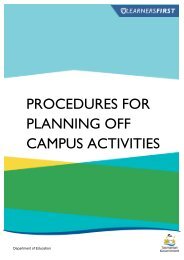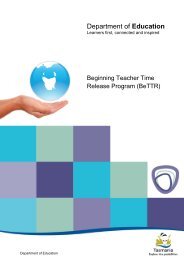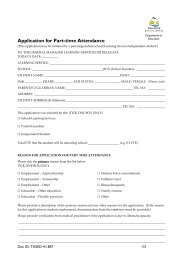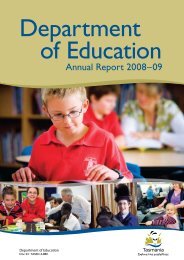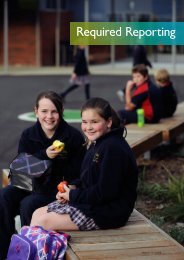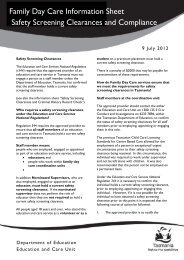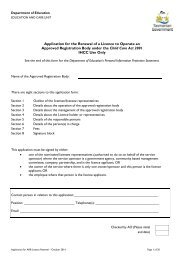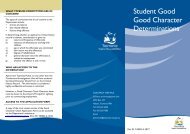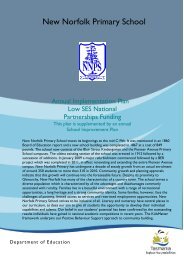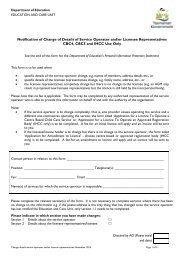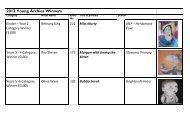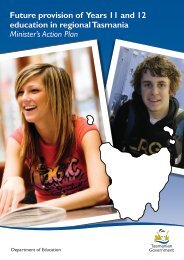Education
DoE Annual Report 2012-2013 - Department of Education
DoE Annual Report 2012-2013 - Department of Education
- No tags were found...
Create successful ePaper yourself
Turn your PDF publications into a flip-book with our unique Google optimized e-Paper software.
Climate Change<br />
The department’s long-term vision is for all Tasmanian<br />
schools to be sustainable with students having the<br />
opportunity to learn as part of a whole school approach<br />
to sustainability.<br />
Under the Tasmanian Framework for Action on Climate Change<br />
the department produced an Emissions Reduction Plan in<br />
2009 which works in conjunction with the department’s<br />
Strategic Asset Management Plan (SAMP) to develop energy<br />
efficiency improvements in existing facilities.<br />
These documents provide the framework for achieving<br />
the department’s broader goals of contributing to<br />
the reduction of global greenhouse gas emissions by<br />
also encouraging innovation in areas such as recycling,<br />
transportation, green building initiatives and moving<br />
towards carbon-neutral facilities. The department<br />
intends to:<br />
• use less energy<br />
• reduce transport/travel related emissions while<br />
maintaining continuity of business operations<br />
• reduce levels of office waste<br />
• develop and lead an education program aimed at<br />
engaging staff, students and the broader community.<br />
Since 2012, sustainability has been a cross-curriculum<br />
priority in the Australian Curriculum and therefore a focus<br />
in all Tasmanian schools. This provides the opportunity<br />
for schools to build on the sustainability initiatives that<br />
they already have in place or to develop a sustainability<br />
focus. The department is supporting schools in their<br />
sustainability work initiatives through the establishment<br />
of the Sustainability Learning Centre (SLC) at Mt Nelson,<br />
identification of sustainability lead schools and the<br />
implementation of the $1 million Sustainability Initiatives<br />
Program.<br />
The department runs an incentive-based energy funding<br />
model which provides improved opportunities for schools<br />
to make long-term commitments to energy savings and<br />
utilise incentives.<br />
Key elements of the department’s initiatives are:<br />
• 5-Star Green Star new schools – the new Kingston<br />
High, Austins Ferry Primary, Romaine Primary,<br />
Windermere Primary and Port Sorell Primary<br />
Schools were designed as 5-Star Green Star facilities<br />
as well as new buildings at the Jordan River Learning<br />
Federation in Bridgewater. The new primary school to<br />
be constructed at Dunalley will also meet the 5-Star<br />
Green Star rating.<br />
• Actively implementing a stringent and ongoing review<br />
of the vehicle fleet requirements to include more fuel<br />
efficient vehicles and the use of hybrid cars where<br />
feasible. All of the department’s light vehicle fleet<br />
meets the minimum greenhouse ratings. Overall,<br />
the size of the fleet has reduced by 32, from 310 in<br />
2010–11 to 278 in 2012–13.<br />
• The introduction of the Energy Saving Guide, an<br />
incentive-based energy funding model and an<br />
increased focus on climate change, has resulted in<br />
a significant reduction in electricity consumption<br />
since 2010.<br />
• Construction of the innovative Sustainability<br />
Learning Centre on the site of the Hobart College<br />
at Mount Nelson is now complete and opened in<br />
November 2012. The $2.8 million centre, funded by<br />
the Australian Government, was built through a<br />
partnership between Greening Australia, CSIRO, the<br />
Department of <strong>Education</strong>, the Tasmanian Catholic<br />
<strong>Education</strong> Office and the Association of Independent<br />
Schools and now:<br />
º º delivers specialist science, ecology and<br />
sustainability education<br />
º º provides a new home for Greening Australia<br />
(Tasmania) which contributed $300,000 to the<br />
project and CSIRO <strong>Education</strong> Centre<br />
º º is the first educational 6-Star Green Star rated<br />
building in Tasmania and used recycled building<br />
materials, and the building demonstrates<br />
sustainability principles as an educational tool<br />
º º encourages ‘hands-on’ education using the<br />
building itself as a tool, nurseries, field activities,<br />
interpretive trails and bush classrooms<br />
º º maximises use of solar energy resulting in<br />
zero net external energy for teaching areas and<br />
feature recycled stormwater and sewerage<br />
º º is a carbon-neutral building in initial construction<br />
and ongoing use and exhibits plant cultivation<br />
and biodiversity<br />
º º utilised materials from a large warehouse and<br />
cottage in Hobart that have been recycled and<br />
make up 70–80% of the new centre’s materials.<br />
• LED emergency exit lights – the department has<br />
implemented a program of replacing conventional<br />
emergency exit lights with energy efficient LED exit<br />
lights. This conversion project is being rolled out in<br />
stages as funds permit. The program has provided<br />
1,780 energy efficient exit lights to 78 schools and<br />
libraries around the state. The new LED lights are<br />
estimated to consume 44kWh of energy per annum –<br />
which is 87% less energy than the traditional exit lights<br />
that consume approximately 350kWh per annum.<br />
• National Solar Schools Program (NSSP) – the objectives<br />
of this Commonwealth-funded scheme are to allow<br />
schools to:<br />
º º generate their own electricity from renewable<br />
sources<br />
º º improve their energy efficiency and reduce their<br />
energy consumption<br />
º º adapt to climate change by making use of<br />
rainwater collected from school roofs<br />
º º provide educational benefits for school students<br />
and their communities.<br />
This program has now wound up, but since its<br />
inception in 2008, a total of 109 Tasmanian schools<br />
have participated with the following outcomes:<br />
º º solar panels have been installed in 103 schools with<br />
a maximum generating capacity of 675.5 kWh<br />
º º two schools have installed wind-powered<br />
generating systems<br />
º º 29 schools have replaced 11,795 lights with high<br />
efficiency units<br />
º º 13 schools have installed rainwater tanks for<br />
irrigation purposes with a capacity of 302,584 litres<br />
º º other energy-efficiency measures including<br />
the installation of heat pumps, solar hot water<br />
units, sensors, timers, thermostats, ceiling fans,<br />
door closers and draught seals.<br />
Required Reporting » Climate Change<br />
79




